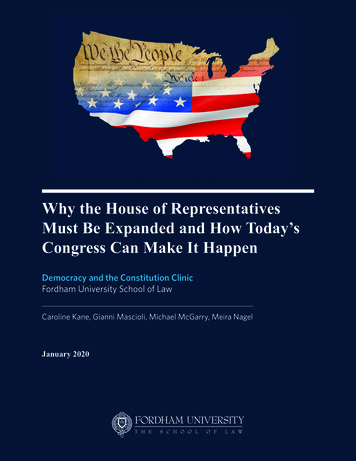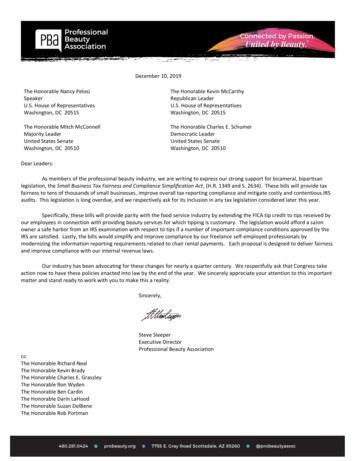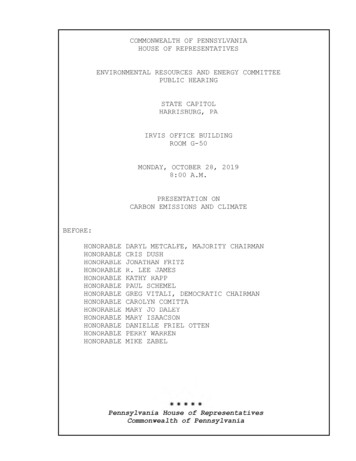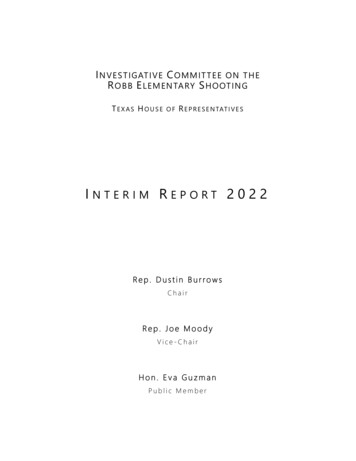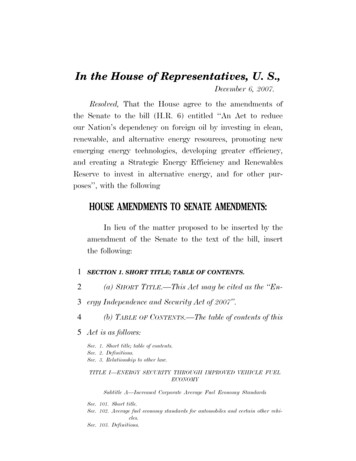
Transcription
In the House of Representatives, U. S.,December 6, 2007.Resolved, That the House agree to the amendments ofthe Senate to the bill (H.R. 6) entitled ‘‘An Act to reduceour Nation’s dependency on foreign oil by investing in clean,renewable, and alternative energy resources, promoting newemerging energy technologies, developing greater efficiency,and creating a Strategic Energy Efficiency and RenewablesReserve to invest in alternative energy, and for other purposes’’, with the followingHOUSE AMENDMENTS TO SENATE AMENDMENTS:In lieu of the matter proposed to be inserted by theamendment of the Senate to the text of the bill, insertthe following:12SECTION 1. SHORT TITLE; TABLE OF CONTENTS.(a) SHORT TITLE.—This Act may be cited as the ‘‘En-3 ergy Independence and Security Act of 2007’’.4(b) TABLE OF CONTENTS.—The table of contents of this5 Act is as follows:Sec. 1. Short title; table of contents.Sec. 2. Definitions.Sec. 3. Relationship to other law.TITLE I—ENERGY SECURITY THROUGH IMPROVED VEHICLE FUELECONOMYSubtitle A—Increased Corporate Average Fuel Economy StandardsSec. 101. Short title.Sec. 102. Average fuel economy standards for automobiles and certain other vehicles.Sec. 103. Definitions.
ec.Sec.Sec.109.110.111.112.113.Credit trading program.Consumer information.Continued applicability of existing standards.National Academy of Sciences studies.National Academy of Sciences study of medium-duty and heavy-dutytruck fuel economy.Extension of flexible fuel vehicle credit program.Periodic review of accuracy of fuel economy labeling procedures.Consumer tire information.Use of civil penalties for research and development.Exemption from separate calculation requirement.Subtitle B—Improved Vehicle 135.136.Transportation electrification.Domestic manufacturing conversion grant program.Inclusion of electric drive in Energy Policy Act of 1992.Loan guarantees for fuel-efficient automobile parts manufacturers.Advanced battery loan guarantee program.Advanced technology vehicles manufacturing incentive program.Subtitle C—Federal Vehicle FleetsSec. 141. Federal vehicle fleets.Sec. 142. Federal fleet conservation requirements.TITLE II—ENERGY SECURITY THROUGH INCREASED PRODUCTIONOF BIOFUELSSubtitle A—Renewable Fuel 3.204.205.206.207.208.Definitions.Renewable fuel standard.Study of impact of Renewable Fuel Standard.Environmental and resource conservation impacts.Biomass based diesel and biodiesel labeling.Study of credits for use of renewable electricity in electric vehicles.Grants for production of advanced biofuels.Integrated consideration of water quality in determinations on fuelsand fuel additives.Sec. 209. Anti-backsliding.Sec. 210. Effective date, savings provision, and transition rules.Subtitle B—Biofuels Research and DevelopmentSec. 221. Biodiesel.Sec. 222. Biogas.Sec. 223. Grants for biofuel production research and development in certainStates.Sec. 224. Biorefinery energy efficiency.Sec. 225. Study of optimization of flexible fueled vehicles to use E–85 fuel.Sec. 226. Study of engine durability and performance associated with the use ofbiodiesel.Sec. 227. Study of optimization of biogas used in natural gas vehicles.Sec. 228. Algal biomass.Sec. 229. Biofuels and biorefinery information center.Sec. 230. Cellulosic ethanol and biofuels research. HR 6 EAH
3Sec.Sec.Sec.Sec.231.232.233.234.Bioenergy research and development, authorization of appropriation.Environmental research and development.Bioenergy research centers.University based research and development grant program.Subtitle C—Biofuels InfrastructureSec. 241. Prohibition on franchise agreement restrictions related to renewable fuelinfrastructure.Sec. 242. Renewable fuel dispenser requirements.Sec. 243. Ethanol pipeline feasibility study.Sec. 244. Renewable fuel infrastructure grants.Sec. 245. Study of the adequacy of transportation of domestically-produced renewable fuel by railroads and other modes of transportation.Sec. 246. Federal fleet fueling centers.Sec. 247. Standard specifications for biodiesel.Sec. 248. Biofuels distribution and advanced biofuels infrastructure.Subtitle D—Environmental SafeguardsSec. 251. Waiver for fuel or fuel additives.TITLE III—ENERGY SAVINGS THROUGH IMPROVED STANDARDSFOR APPLIANCE AND LIGHTINGSubtitle A—Appliance Energy Sec. 9.310.311.312.313.314.315.Sec. 316.External power supply efficiency standards.Updating appliance test procedures.Residential boilers.Furnace fan standard process.Improving schedule for standards updating and clarifying State authority.Regional standards for furnaces, central air conditioners, and heatpumps.Procedure for prescribing new or amended standards.Expedited rulemakings.Battery chargers.Standby mode.Energy standards for home appliances.Walk-in coolers and walk-in freezers.Electric motor efficiency standards.Standards for single package vertical air conditioners and heat pumps.Improved energy efficiency for appliances and buildings in cold climates.Technical corrections.Subtitle B—Lighting Energy Efficient light bulbs.Incandescent reflector lamp efficiency standards.Public building energy efficient and renewable energy systems.Metal halide lamp fixtures.Energy efficiency labeling for consumer electronic products.TITLE IV—ENERGY SAVINGS IN BUILDINGS AND INDUSTRYSec. 401. Definitions. HR 6 EAH
4Subtitle A—Residential Building EfficiencySec. 411. Reauthorization of weatherization assistance program.Sec. 412. Study of renewable energy rebate programs.Sec. 413. Energy code improvements applicable to manufactured housing.Subtitle B—High-Performance Commercial BuildingsSec. 421. Commercial high-performance green buildings.Sec. 422. Zero Net Energy Commercial Buildings Initiative.Sec. 423. Public outreach.Subtitle C—High-Performance Federal rgy reduction goals for Federal buildings.Management of energy and water efficiency in Federal buildings.Federal building energy efficiency performance standards.Management of Federal building efficiency .Leasing.High-performance green Federal buildings.Federal green building performance.Storm water runoff requirements for Federal development projects.Cost-effective technology acceleration program.Authorization of appropriations.Public building life-cycle costs.Subtitle D—Industrial Energy EfficiencySec. 451. Industrial energy efficiency.Sec. 452. Energy-intensive industries program.Sec. 453. Energy efficiency for data center buildings.Subtitle E—Healthy High-Performance SchoolsSec. 461. Healthy high-performance schools.Sec. 462. Study on indoor environmental quality in schools.Subtitle F—Institutional EntitiesSec. 471. Energy sustainability and efficiency grants and loans for institutions.Subtitle G—Public and Assisted HousingSec. 481. Application of International Energy Conservation Code to public andassisted housing.Subtitle H—General ProvisionsSec. 491. Demonstration project.Sec. 492. Research and development.Sec. 493. Environmental Protection Agency demonstration grant program forlocal governments.Sec. 494. Green Building Advisory Committee.Sec. 495. Advisory Committee on Energy Efficiency Finance. HR 6 EAH
5TITLE V—ENERGY SAVINGS IN GOVERNMENT AND PUBLICINSTITUTIONSSubtitle A—United States Capitol itol complex photovoltaic roof feasibility studies.Capitol complex E–85 refueling station.Energy and environmental measures in Capitol complex master plan.Promoting maximum efficiency in operation of Capitol power plant.Capitol power plant carbon dioxide emissions feasibility study anddemonstration projects.Subtitle B—Energy Savings Performance ContractingSec. 511. Authority to enter into contracts; reports.Sec. 512. Financing flexibility.Sec. 513. Promoting long-term energy savings performance contracts andverifying savings.Sec. 514. Permanent reauthorization.Sec. 515. Definition of energy savings.Sec. 516. Retention of savings.Sec. 517. Training Federal contracting officers to negotiate energy efficiency contracts.Sec. 518. Study of energy and cost savings in nonbuilding applications.Subtitle C—Energy Efficiency in Federal AgenciesSec. 521. Installation of photovoltaic system at Department of Energy headquarters building.Sec. 522. Prohibition on incandescent lamps by Coast Guard.Sec. 523. Standard relating to solar hot water heaters.Sec. 524. Federally-procured appliances with standby power.Sec. 525. Federal procurement of energy efficient products.Sec. 526. Procurement and acquisition of alternative fuels.Sec. 527. Government efficiency status reports.Sec. 528. OMB government efficiency reports and scorecards.Sec. 529. Electricity sector demand response.Subtitle D—Energy Efficiency of Public InstitutionsSec. 531. Reauthorization of State energy programs.Sec. 532. Utility energy efficiency programs.Subtitle E—Energy Efficiency and Conservation Block 544.545.546.547.548.Definitions.Energy Efficiency and Conservation Block Grant Program.Allocation of funds.Use of funds.Requirements for eligible entities.Competitive grants.Review and evaluation.Funding. HR 6 EAH
6TITLE VI—ACCELERATED RESEARCH AND DEVELOPMENTSubtitle A—Solar 605.606.607.Short title.Thermal energy storage research and development program.Concentrating solar power commercial application studies.Solar energy curriculum development and certification grants.Daylighting systems and direct solar light pipe technology.Solar Air Conditioning Research and Development Program.Photovoltaic demonstration program.Subtitle B—Geothermal 9.620.621.622.623.624.625.Short title.Definitions.Hydrothermal research and development.General geothermal systems research and development.Enhanced geothermal systems research and development.Geothermal energy production from oil and gas fields and recovery andproduction of geopressured gas resources.Cost sharing and proposal evaluation.Center for geothermal technology transfer.GeoPowering America.Educational pilot program.Reports.Applicability of other laws.Authorization of appropriations.International geothermal energy development.High cost region geothermal energy grant program.Subtitle C—Marine and Hydrokinetic Renewable Energy TechnologiesSec.Sec.Sec.Sec.631.632.633.634.Short title.Definition.Marine and hydrokinetic renewable energy research and development.National Marine Renewable Energy Research, Development, and Demonstration Centers.Sec. 635. Applicability of other laws.Sec. 636. Authorization of appropriations.Subtitle D—Energy Storage for Transportation and Electric PowerSec. 641. Energy storage competitiveness.Subtitle E—Miscellaneous 655.656.Lightweight materials research and development.Commercial insulation demonstration program.Technical criteria for clean coal power Initiative.H-Prize.Bright Tomorrow Lighting Prizes.Renewable Energy innovation manufacturing partnership. HR 6 EAH
7TITLE VII—CARBON CAPTURE AND SEQUESTRATIONSubtitle A—Carbon Capture and Sequestration Research, Development, andDemonstrationSec. 701. Short title.Sec. 702. Carbon capture and sequestration research, development, and demonstration program.Sec. 703. Carbon capture.Sec. 704. Review of large-scale programs.Sec. 705. Geologic sequestration training and research.Sec. 706. Relation to Safe Drinking Water Act.Sec. 707. Safety research.Sec. 708. University based research and development grant program.Subtitle B—Carbon Capture and Sequestration Assessment and FrameworkSec. 711. Carbon dioxide sequestration capacity assessment.Sec. 712. Assessment of carbon sequestration and methane and nitrous oxideemissions from ecosystems.Sec. 713. Carbon dioxide sequestration inventory.Sec. 714. Framework for geological carbon sequestration on public land.TITLE VIII—IMPROVED MANAGEMENT OF ENERGY POLICYSubtitle A—Management 4.805.806.National media campaign.Alaska Natural Gas Pipeline administration.Renewable energy deployment.Coordination of planned refinery outages.Assessment of resources.Sense of Congress relating to the use of renewable resources to generateenergy.Sec. 807. Geothermal assessment, exploration information, and priority activities.Subtitle B—Prohibitions on Market Manipulation and False .Prohibition on market manipulation.Prohibition on false information.Enforcement by the Federal Trade Commission.Penalties.Effect on other laws.TITLE IX—INTERNATIONAL ENERGY PROGRAMSSec. 901. Definitions.Subtitle A—Assistance to Promote Clean and Efficient Energy Technologies inForeign CountriesSec. 911. United States assistance for developing countries.Sec. 912. United States exports and outreach programs for India, China, andother countries.Sec. 913. United States trade missions to encourage private sector trade and investment.Sec. 914. Actions by Overseas Private Investment Corporation.Sec. 915. Actions by United States Trade and Development Agency. HR 6 EAH
8Sec. 916. Deployment of international clean and efficient energy technologies andinvestment in global energy markets.Sec. 917. United States-Israel energy cooperation.Subtitle B—International Clean Energy 924.925.926.927.Definitions.Establishment and management of Foundation.Duties of Foundation.Annual report.Powers of the Foundation; related provisions.General personnel authorities.Authorization of appropriations.Subtitle C—Miscellaneous ProvisionsSec.Sec.Sec.Sec.931.932.933.934.Energy diplomacy and security within the Department of State.National Security Council reorganization.Annual national energy security strategy report.Convention on Supplementary Compensation for Nuclear Damage contingent cost allocation.Sec. 935. Transparency in extractive industries resource payments.TITLE X—GREEN JOBSSec. 1001. Short title.Sec. 1002. Energy efficiency and renewable energy worker training program.TITLE XI—ENERGY TRANSPORTATION AND INFRASTRUCTURESubtitle A—Department of TransportationSec. 1101. Office of Climate Change and Environment.Subtitle B—RailroadsSec. 1111. Advanced technology locomotive grant pilot program.Sec. 1112. Capital grants for class II and class III railroads.Subtitle C—Marine TransportationSec. 1121. Short sea transportation initiative.Sec. 1122. Short sea shipping eligibility for capital construction fund.Sec. 1123. Short sea transportation report.Subtitle D—HighwaysSec. 1131. Increased Federal share for CMAQ projects.Sec. 1132. Distribution of rescissions.Sec. 1133. Sense of Congress regarding use of complete streets design techniques.TITLE XII—SMALL BUSINESS ENERGY PROGRAMSSec. 1201. Express loans for renewable energy and energy efficiency.Sec. 1202. Pilot program for reduced 7(a) fees for purchase of energy efficienttechnologies.Sec. 1203. Small business energy efficiency.Sec. 1204. Larger 504 loan limits to help business develop energy efficient technologies and purchases. HR 6 EAH
9Sec.Sec.Sec.Sec.1205.1206.1207.1208.Energy saving debentures.Investments in energy saving small businesses.Renewable fuel capital investment company.Study and report.TITLE XIII—SMART .1304.1305.1306.1307.1308.Statement of policy on modernization of electricity grid.Smart grid system report.Smart grid advisory committee and smart grid task force.Smart grid technology research, development, and demonstration.Smart grid interoperability framework.Federal matching fund for smart grid investment costs.State consideration of smart grid.Study of the effect of private wire laws on the development of combinedheat and power facilities.Sec. 1309. DOE study of security attributes of smart grid systems.TITLE XIV—RENEWABLE ELECTRICITY STANDARDSec. 1401. Renewable electricity standard.TITLE XV—CLEAN RENEWABLE ENERGY AND CONSERVATION TAXACT OF 2007Sec. 1500. Short title; amendment of 1986 Code.Subtitle A—Clean Renewable Energy Production IncentivesPART I—PROVISIONS RELATINGSec.Sec.Sec.Sec.TORENEWABLE ENERGY1501.1502.1503.1504.Extension and modification of renewable energy credit.Production credit for electricity produced from marine renewables.Extension and modification of energy credit.Extension and modification of credit for residential energy efficientproperty.Sec. 1505. Extension and modification of special rule to implement FERC andState electric restructuring policy.Sec. 1506. New clean renewable energy bonds.PART II—PROVISIONS RELATINGTOCARBON MITIGATIONANDCOALSec. 1507. Expansion and modification of advanced coal project investment credit.Sec. 1508. Expansion and modification of coal gasification investment credit.Sec. 1509. Seven-year applicable recovery period for depreciation of qualified carbon dioxide pipeline property.Sec. 1510. Special rules for refund of the coal excise tax to certain coal producersand exporters.Sec. 1511. Extension of temporary increase in coal excise tax.Sec. 1512. Carbon audit of the tax code.Subtitle B—Transportation and Domestic Fuel SecurityPART I—BIOFUELSSec. 1521. Credit for production of cellulosic biomass alcohol. HR 6 EAH
10Sec. 1522. Expansion of special allowance to cellulosic biomass alcohol fuel plantproperty.Sec. 1523. Modification of alcohol credit.Sec. 1524. Extension and modification of credits for biodiesel and renewable diesel.Sec. 1525. Clarification of eligibility for renewable diesel credit.Sec. 1526. Provisions clarifying treatment of fuels with no nexus to the UnitedStates.Sec. 1527. Comprehensive study of biofuels.PART II—ADVANCED TECHNOLOGY MOTOR VEHICLESSec. 1528. Credit for new qualified plug-in electric drive motor vehicles.Sec. 1529. Exclusion from heavy truck tax for idling reduction units and advanced insulation.PART III—OTHER TRANSPORTATION PROVISIONSSec. 1530. Restructuring of New York Liberty Zone tax credits.Sec. 1531. Extension of transportation fringe benefit to bicycle commuters.Subtitle C—Energy Conservation and EfficiencyPART I—CONSERVATION TAX CREDIT BONDSSec. 1541. Qualified energy conservation bonds.Sec. 1542. Qualified forestry conservation bonds.PART II—EFFICIENCYSec. 1543. Extension and modification of energy efficient existing homes credit.Sec. 1544. Extension and modification of energy efficient commercial buildingsdeduction.Sec. 1545. Modifications of energy efficient appliance credit for appliances produced after 2007.Sec. 1546. Seven-year applicable recovery period for depreciation of qualified energy management devices.Subtitle D—Other ProvisionsPART I—FORESTRY PROVISIONSSec. 1551. Deduction for qualified timber gain.Sec. 1552. Excise tax not applicable to section 1203 deduction of real estate investment trusts.Sec. 1553. Timber REIT modernization.Sec. 1554. Mineral royalty income qualifying income for timber REITs.Sec. 1555. Modification of taxable REIT subsidiary asset test for timber REITs.Sec. 1556. Safe harbor for timber property.PART II—EXXON VALDEZSec. 1557. Income averaging for amounts received in connection with the ExxonValdez litigation.Subtitle E—Revenue ProvisionsSec. 1561. Limitation of deduction for income attributable to domestic productionof oil, gas, or a primary products thereof. HR 6 EAH
11Sec. 1562. Elimination of the different treatment of foreign oil and gas extractionincome and foreign oil related income for purposes of the foreigntax credit.Sec. 1563. Seven-year amortization of geological and geophysical expenditures forcertain major integrated oil companies.Sec. 1564. Broker reporting of customer’s basis in securities transactions.Sec. 1565. Extension of additional 0.2 percent FUTA surtax.Sec. 1566. Termination of treatment of natural gas distribution lines as 15-yearproperty.Sec. 1567. Time for payment of corporate estimated taxes.Sec. 1568. Modification of penalty for failure to file partnership returns.Subtitle F—Secure Rural SchoolsSec. 1571. Secure rural schools and community self-determination program.1SEC. 2. DEFINITIONS.2In this Act:345(1) DEPARTMENT.—The term ‘‘Department’’means the Department of Energy.(2) INSTITUTIONOF HIGHER EDUCATION.—The6term ‘‘institution of higher education’’ has the mean-7ing given the term in section 101(a) of the Higher8Education Act of 1965 (20 U.S.C. 1001(a)).9101112(3) SECRETARY.—The term ‘‘Secretary’’ meansthe Secretary of Energy.SEC. 3. RELATIONSHIP TO OTHER LAW.Except to the extent expressly provided in this Act or13 an amendment made by this Act, nothing in this Act or14 an amendment made by this Act supersedes, limits the au15 thority provided or responsibility conferred by, or author16 izes any violation of any provision of law (including a reg17 ulation), including any energy or environmental law or18 regulation. HR 6 EAH
125TITLEI—ENERGYSECURITYTHROUGH IMPROVED VEHICLE FUEL ECONOMYSubtitle A—Increased CorporateAverage Fuel Economy Standards6SEC. 101. SHORT TITLE.12347This subtitle may be cited as the ‘‘Ten-in-Ten Fuel8 Economy Act’’.9SEC. 102. AVERAGE FUEL ECONOMY STANDARDS FOR AUTO-1011MOBILES AND CERTAIN OTHER VEHICLES.(a) INCREASED STANDARDS.—Section 32902 of title12 49, United States Code, is amended—13(1) in subsection (a)—14(A) by striking ‘‘NON-PASSENGER ION.—’’;(B) by striking ‘‘(except passenger automobiles)’’ in subsection (a); and1920and inserting ‘‘PRESCRIPTION(C) by striking the last sentence;(2) by striking subsection (b) and inserting the21following:22‘‘(b) STANDARDSFORAUTOMOBILESANDCERTAIN23 OTHER VEHICLES.—2425‘‘(1) INGENERAL.—TheSecretary of Transpor-tation, after consultation with the Secretary of En HR 6 EAH
131ergy and the Administrator of the Environmental2Protection Agency, shall prescribe separate average3fuel economy standards for—4‘‘(A) passenger automobiles manufactured5by manufacturers in each model year beginning6with model year 2011 in accordance with this7subsection;8‘‘(B) non-passenger automobiles manufac-9tured by manufacturers in each model year be-10ginning with model year 2011 in accordance11with this subsection;1213‘‘(C) work trucks in accordance with subsection (k); and14‘‘(D) commercial medium-duty or heavy-15duty on-highway vehicles in accordance with16subsection (l).17‘‘(2) FUEL18ECONOMY STANDARDS FOR AUTO-MOBILES.—19‘‘(A) AUTOMOBILEFUEL ECONOMY AVERAGE20FOR MODEL YEARS 2011 THROUGH 2020.—The21Secretary shall prescribe a separate average fuel22economy standard for passenger automobiles and23a separate average fuel economy standard for24non-passenger automobiles for each model year25beginning with model year 2011 to achieve a HR 6 EAH
141combined fuel economy average for model year22020 of at least 35 miles per gallon for the total3fleet of passenger and non-passenger automobiles4manufactured for sale in the United States for5that model year.6‘‘(B) AUTOMOBILEFUEL ECONOMY AVERAGE7FOR MODEL YEARS 2021 THROUGH 2030.—For8model years 2021 through 2030, the average fuel9economy required to be attained by each fleet of10passenger and non-passenger automobiles manu-11factured for sale in the United States shall be the12maximum feasible average fuel economy stand-13ard for each fleet for that model year.14‘‘(C) PROGRESSTOWARD STANDARD RE-15QUIRED.—In16standards under subparagraph (A), the Sec-17retary shall prescribe annual fuel economy18standard increases that increase the applicable19average fuel economy standard ratably beginning20with model year 2011 and ending with model21year 2020.22‘‘(3) AUTHORITY23prescribing average fuel economyOF THE SECRETARY.—TheSec-retary shall—24‘‘(A) prescribe by regulation separate aver-25age fuel economy standards for passenger and HR 6 EAH
151non-passenger automobiles based on 1 or more2vehicle attributes related to fuel economy and ex-3press each standard in the form of a mathe-4matical function; and5‘‘(B) issue regulations under this title pre-6scribing average fuel economy standards for at7least 1, but not more than 5, model years.8‘‘(4) MINIMUMSTANDARD.—Inaddition to any9standard prescribed pursuant to paragraph (3), each10manufacturer shall also meet the minimum standard11for domestically manufactured passenger automobiles,12which shall be the greater of—13‘‘(A) 27.5 miles per gallon; or14‘‘(B) 92 percent of the average fuel economy15projected by the Secretary for the combined do-16mestic and non-domestic passenger automobile17fleets manufactured for sale in the United States18by all manufacturers in the model year, which19projection shall be published in the Federal Reg-20ister when the standard for that model year is21promulgated in accordance with this section.’’;22and23(3) in subsection (c)— HR 6 EAH
161(A) by striking ‘‘(1) Subject to paragraph2(2) of this subsection, the’’ and inserting ‘‘The’’;3and45(B) by striking paragraph (2).(b) FUEL ECONOMY STANDARDFORWORK TRUCKS.—6 Section 32902 of title 49, United States Code, is amended7 by adding at the end the following:8‘‘(k) WORK TRUCKS.—9‘‘(1) STUDY.—Not later than 1 year after the10date of the enactment of the Ten-in-Ten Fuel Econ-11omy Act, the Secretary of Transportation, in con-12sultation with the Secretary of Energy and the Ad-13ministrator of the Environmental Protection Agency,14shall examine the fuel efficiency of work trucks and15determine—16‘‘(A) the appropriate test procedures and17methodologies for measuring the fuel efficiency of18work trucks;19‘‘(B) the appropriate metric for measuring20and expressing work truck fuel efficiency per-21formance, taking into consideration, among other22things, the work performed by work trucks and23types of operations in which they are used;24‘‘(C) the range of factors, including, without25limitation, design, functionality, use, duty cycle, HR 6 EAH
171infrastructure, and total overall energy consump-2tion and operating costs that affect work truck3fuel efficiency; and4‘‘(D) such other factors and conditions that5could have an impact on a program to improve6work truck fuel efficiency.7‘‘(2) RULEMAKING.—Not later than 24 months8after completion of the study required under para-9graph (1), the Secretary, in consultation with the Sec-10retary of Energy and the Administrator of the Envi-11ronmental Protection Agency, by regulation, shall de-12termine in a rulemaking proceeding how to imple-13ment a work truck fuel efficiency improvement pro-14gram designed to achieve the maximum feasible im-15provement, and shall adopt and implement appro-16priate test methods, measurement metrics, fuel econ-17omy standards, and compliance and enforcement pro-18tocols that are appropriate, cost-effective, and techno-19logically feasible for work trucks. Any fuel economy20standard prescribed under this section shall be pre-21scribed at least 18 months before the model year to22which it applies. The Secretary may prescribe sepa-23rate standards for different classes of vehicles under24this subsection.’’. HR 6 EAH
1812(c) FUEL ECONOMY STANDARDDIUM-DUTY ANDFORCOMMERCIAL ME-HEAVY-DUTY ON-HIGHWAY VEHICLES.—3 Section 32902 of title 49, United States Code, as amended4 by subsection (b), is further amended by adding at the end5 the following:6‘‘(l) COMMERCIAL MEDIUM-ANDHEAVY-DUTY ON-7 HIGHWAY VEHICLES.—8‘‘(1) STUDY.—Not later than 1 year after the9National Academy of Sciences publishes the results of10its study under section 108 of the Ten-in-Ten Fuel11Economy Act, the Secretary of Transportation, in12consultation with the Secretary of Energy and the13Administrator of the Environmental Protection Agen-14cy, shall examine the fuel efficiency of commercial15medium- and heavy-duty on-highway vehicles and de-16termine—17‘‘(A) the appropriate test procedures and18methodologies for measuring the fuel efficiency of19such vehicles;20‘‘(B) the appropriate metric for measuring21and expressing commercial medium- and heavy-22duty on-highway vehicle fuel efficiency perform-23ance, taking into consideration, among other24things, the work performed by such on-highway HR 6 EAH
191vehicles and types of operations in which they2are used;3‘‘(C) the range of factors, including, without4limitation, design, functionality, use, duty cycle,5infrastructure, and total overall energy consump-6tion and operating costs that affect commercial7medium- and heavy-duty on-highway vehicle fuel8efficiency; and9‘‘(D) such other factors and conditions that10could have an impact on a program to improve11commercial medium- and heavy-duty on-high-12way vehicle fuel efficiency.13‘‘(2) RULEMAKING.—Not later than 24 months14after completion of the study required under para-15graph (1), the Secretary, in consultation with the Sec-16retary of Energy and the Administrator of the Envi-17ronmental Protection Agency, by regulation, shall de-18termine in a rulemaking proceeding how to imple-19ment a commercial medium- and heavy-duty on-high-20way vehicle fuel efficiency improvement program de-21signed to achieve the maximum feasible improvement,22and shall adopt and implement appropriate test23methods, measurement metrics, fuel economy stand-24ards, and compliance and enforcement protocols that25are appropriate, cost-effective, and technologically fea- HR 6 EAH
201sible for commercial medium- and heavy-duty on-2highway vehicles. Any fuel economy standard pre-3scribed under this section shall be prescribed at least418 months before the model year to which it applies.5The Secretary may prescribe separate standards for6different classes of vehicles under this subsection.7‘‘(3) LEAD-TIME;REGULATORY STABILITY.—The8first commercial medium- and he
In the House of Representatives, U. S., December 6, 2007. Resolved, . 3 ergy Independence and Security Act of 2007''. 4 (b) TABLE OF CONTENTS.—The table of contents of this 5 Act is as follows: Sec. 1. Short title; table of contents. . Sec. 655. Bright Tomorrow Lighting Prizes. Sec. 656. Renewable Energy innovation manufacturing .






